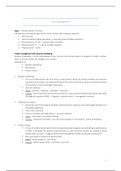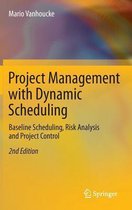Project management
Exam -> exercise-based, no theory
5/6 exercises covering all topics of the course, all start with drawing a network!
1. PERT exercise
2. Exercise related to game we played -> time/cost trade-off (idea important!)
3. Risk analysis (CI, SI, SSI) -> output of MC-simulation
4. Resources (NV, CC...) -> will be a harder question
5. Project control -> EVM
Project management with dynamic scheduling
Dynamic scheduling -> a PM methodology to plan, monitor and control projects in progress in order to deliver
them on time and within the budget to your clients.
Integration of :
Baseline scheduling
Risk analysis
Project control
Baseline scheduling
The act of determining start and finish to each activity within the activity network and resource
constraints and results in an expected timing of the work to be done as well as an expected impact
on the project’s time and budget implications.
Point-of-reference
Inputs : activities – relations – estimates – resources
Outputs : Gantt chart (start & finish of each activity) – time and cost forecasts (planned duration (PD)
& budget at completion (BAC) -> together = planned value ) – management reserves
Schedule risk analysis
Assess the risk of the baseline schedule and forecast the impact to time and budget deviations on
the project objectives
Time / cost / resource
Focus on activities with high impact -> accurate response
Inputs : risk profiles – simulation settings
Outputs : sensitivity chart (SSI) – accuracy charts (quality of risk analysis) – action thresholds µ
Project control
The act of monitoring deviations from the expected project progress and controlling its performance
in order to facilitate the decision making process in case corrective actions are needed to bring
projects back on track -> usage of earned value management (EVM) and earned schedule (ES)
Early warnings for problems & opportunities
Inputs : activity progress – key metrics
Outputs : performance metrics – forecasts – accuracy
1
, An introduction
Dynamic scheduling -> 3 components :
Baseline scheduling : be prepared = planning
Tool to analyse your risk -> point-of-reference
When things go wrong, solve it -> take actions
Schedule risk analysis : know your weak points
Project control : take actions if necessary
Project scheduling is a dynamic process that involves a continuous stream of changes and that is a never ending
process to support decisions that need to be made along the life of the project.
A project
= A temporary endeavour, having a defined beginning and end, undertaken to meet unique goals and
objectives, usually to bring about beneficial change or added value.
A clear start and end (e.g. building a bridge) ≠ producing a car in a factory (today and tomorrow the same)
E.g. : construction project, a building, development of a phone... -> You need objectives!
Project objectives
= The three critical aspect of a project are timing, and cost and delivering the project
according to the specifications.
Specifications : deliver as promised (not the most important regarding
management)
Cost : you want to make money as a contractor -> lowest possible cost =>
internal objective
Time : clear start and end -> promise a deadline => objective towards client
Project management
= Planning, managing and controlling a project in order to deliver a successful project (on time, on budget, on
specs)
Integrated (simplified) view on project life cycle :
You start with an idea (concept), you plan it (activities, cost -> scheduling), then you control it by looking at
the reality (reality is often different than planning because of risk) and lastly you evaluate.
2
,A project can be divided in different phases according to :
Concept : initiation, identification, selection...
Definition : feasibility, development, demonstration, design prototype...
Execution : implementation, production, install and test...
Closeout : termination and post completion evaluation
Between the various phases are decision points.
What is project management?
Law in Project Management (APICS)
No major project is ever installed on time, within budget or with the same staff that started it!
Dynamic scheduling
Project life cycle
Concept : an organization identifies the need for a project or receives a request from a customer.
Project definition : the organization defined the project objectives, the project specifications and
requirements and the organization of the whole project. A list of activities will be made taken precedence
relations and resource availabilities and requirements into account.
Project scheduling : construction of a timetable for the project activities (they get a start and a finish).
Project progress + project control : the project has to be monitored and controlled to see whether it is
performed according to the existing schedule -> if needed : corrections. There is a feedback loop between
control and scheduling -> an update of the schedule can be done in two basic ways :
Reactive scheduling : change when something happens -> act when necessary
Proactive scheduling : risks are taken into account before it can happen = buffered schedule -> think
before you act
Project termination : completion and critical evaluation of the project
3
, Project mapping
Project mapping
How can I map techniques to characteristics (resources and risk) of a project?
A lot of tool and techniques, but put things into the right perspective
Project success is the final goal, which requires integration of tools and techniques
Complexity has to do with resources, since they are scarce = people, machines.
Uncertainty has to do with risk.
Baseline scheduling
PERT / CPM = program evaluation and review technique / critical path method
Basic scheduling techniques without the presence of limited resource availability
e.g. Fabricom – luggage transport small team -> low complexity
Schedule risk analysis
SRA = schedule risk analysis
Provide a certain degree of confidence to the schedule estimates -> Used after PERT / CPM
e.g. Brabantia – marketing project small team
Resource allocation
RCP = resource constrained scheduling
Complex scheduling techniques within the presence of limited resource availability
e.g. Vlaamse Maatschappij voor Watervoorziening (VMW) – Westerscheldetunnel (WST)
CC / BM = critical chain / buffer management
Scheduling approach with main emphasis on the project resources and buffer management to assess
the performance of a project
e.g. New product development (NPD), like iPhone – CERN in Genova
4
, Baseline scheduling
Point of reference for risk analysis
Used for project control
Outline
What? Define your project – activities, precedence relations and
renewable resources
When? Earlies start and latest start schedule – critical path
How? PERT and CPM technique
Why? The real purpose of a project schedule is to act as a predictive model
of a team of resources and the project work destined for that team. A plan can never be follow exactly -> it is
predictive. You don’t need a plan, but when sth goes wrong you can use the plan to find your way back.
A real-life project : Vlaamse Maatschappij voor Watervoorziening (WMV)
Water production centre, 2.5 million customers with a pipeline network of 27,000 km and a yearly production
of 140 billion litters of water.
Project : capacity expansion project in 2 phases.
PLC – phase 1 : the concept
“Identify the need for a project or receive a request from a customer.” -> They needed more water in the future,
but the capacity was already 100% -> project : capacity expansion
PLC – phase 2 : definition = what-phase => prepare everything to find a plan
“Define the project objectives, the project specifications and requirements and the organization of the whole
project.”
P : who is responsible = people -> you need expertise -> 2
Estimate the time
Resource allocation
Risk analysis
L : determine the sequence = links -> 3
Technological links between activities
A : determine the activities -> 1
List of activities
Work breakdown structure (WBS)
N : network analysis -> this is input for scheduling phase -> 4
Work breakdown structure (WBS) = decomposition of major project deliverables
The WBS is used for technical planning and status achievement. Often in conjunction with the organization
breakdown structure (OBS). The OBS indicates the organizational relationships and is used as the framework
for assigning work responsibilities. WBS and OBS together form the Responsibility Assignment Matrix (RAM).
Each descending level = an increased level of detail
Failing to identify all important tasks is a primary contributor to the failure of a project!
5
, The VMW definition phase
Target : capacity expansion of treated water
2 phases :
Subproject 1 : extension of the storage capacity of treated water
Subproject 2 : increase of the production capacity -> is a project with as target maximization NPV,
since it costs a lot and runs over 7 years. € more worth today than tomorrow
⬧ Positive CF (cashflow) asap
⬧ Negative CH alap
Example of a WBS (part of the VMW project)
A certain person will be assigned to control a
certain phase.
From WBS :
Activities and additional information are
known
Technological precedence relations
between these activities are known = the
links between the various activities are
known to incorporate the logical sequences
6





